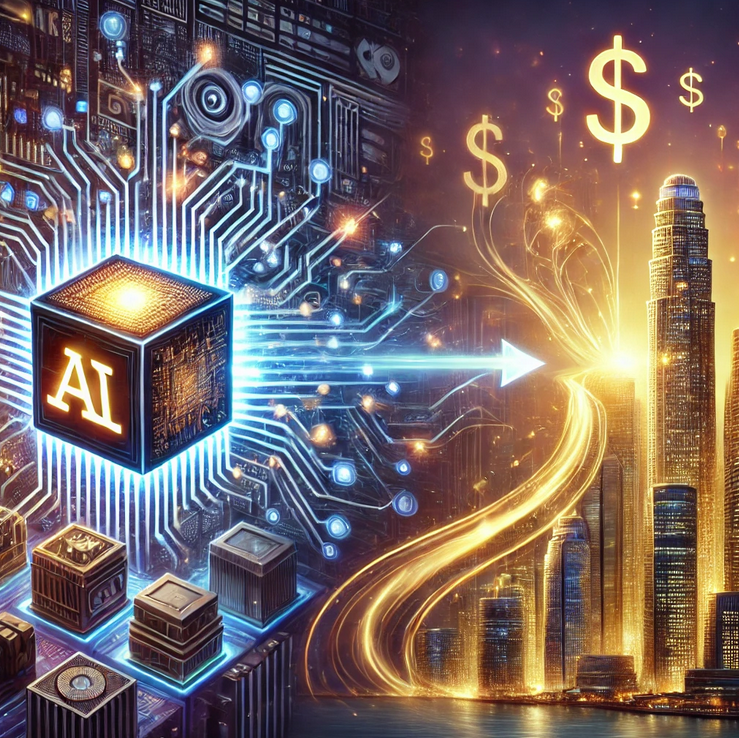(NVDA), (AMZN), (GOOG), (MSFT), (AMD), (TSM)
If Moore's Law had a therapist, today's session would be about AI. "Doctor, I can't keep up with their demands!" it would say. "These AI models are getting needier than my ex."
After riding every tech wave since CPUs ran at 8MHz, I recognize this moment: the AI industry is hitting what physicists call a phase transition - that point when adding more heat doesn't make water any hotter, it just turns it into steam.
And steam, my friends, is exactly what we're seeing come out of some AI companies' valuations.
For years, AI companies played a simple game - throw more computing power at the problem, add more data, watch the magic happen. It worked beautifully, until it didn't.
Think of it this way: OpenAI's GPT-4, released over two years ago, is like that trader who peaked early - still impressive, but newer models with bigger budgets aren't managing to beat its performance.
But markets, like nature, abhor a vacuum. While everyone was obsessing over model size, something more interesting emerged: test-time compute.
Instead of training ever-larger models upfront (think of it as cramming for an exam), test-time compute lets AI systems reason through problems step-by-step in real-time (more like thinking through questions during the test).
OpenAI's experimental "o1" model proved this brilliantly: given 20 seconds to analyze a poker game, it matched the performance of models 100,000 times its size. This isn't just an incremental improvement - it's a fundamental shift in how AI processes information, similar to how high-frequency trading revolutionized market making.
Now, let's talk about where the smart money is flowing. The hardware market is about to go through the kind of transformation I witnessed in the early days of the internet boom.
Remember when everyone thought AOL would dominate the internet forever? That's the kind of assumption we need to challenge here.
NVIDIA, with a market cap $3.48 trillion, has been the undisputed champion of AI chips, with data center revenue soaring 171% to $10.32 billion in 2023. But just as I learned in my early days of trading, market dominance can be a temporary condition.
AMD, with a market of $282 billion, is making serious moves in the inference hardware space, with their stock up 75% in 2023. Their lower valuation and strategic focus on inference chips positions them perfectly for the test-time compute revolution.
Meanwhile, Taiwan Semiconductor Manufacturing’s (TSM) 43% revenue increase isn't just a number - it's a signal. With a P/E of 22 and their commanding lead in advanced chip manufacturing, they're the picks-and-shovels play in this new gold rush.
Next, let’s take a look at the cloud providers - Amazon (AMZN), Microsoft (MSFT), and Google (GOOG) - which hold a unique position here.
Amazon's AWS division raked in $23.1 billion in operating income, while Microsoft's Azure revenue jumped 29% in 2023 through their OpenAI partnership.
Alphabet's DeepMind might look like a money pit to traditional analysts - their "Other Bets" category pulled in $1.29 billion in 2023 - but they're actually rethinking how AI computes.
Aside from these big names, a handful of up and coming companies are making waves as well.
One of them is Cerebras Systems, the current leader in specialized AI hardware with their wafer-scale engine - essentially an entire datacenter on a chip.
While still private, they're showing how radical innovation in hardware architecture can leapfrog traditional approaches.
We're seeing a shift from massive training clusters to what I call "thinking infrastructure" - distributed systems optimized for real-time processing.
Looking at the broader market, we're entering what I consider a sorting period.
The companies that understand this shift away from scale will thrive. Those still playing the old game of bigger-is-better will struggle.
So, what’s the play? I say buy the dip for AMD since their focus on inference chips and reasonable valuation makes them perfectly positioned for the test-time compute revolution.
Do the same for TSM. Their manufacturing prowess and diverse customer base provide both stability and upside in this transition.
Meanwhile, press pause on NVIDIA for now. Despite their premium valuation, their technical leadership and massive installed base warrant holding positions. Still, be on the lookout for signs of adaptation to the new rules.
Most importantly, set tight stops - this transition period will be volatile. I'm looking at a 6-12 month horizon here, with position reviews every 30 days.


